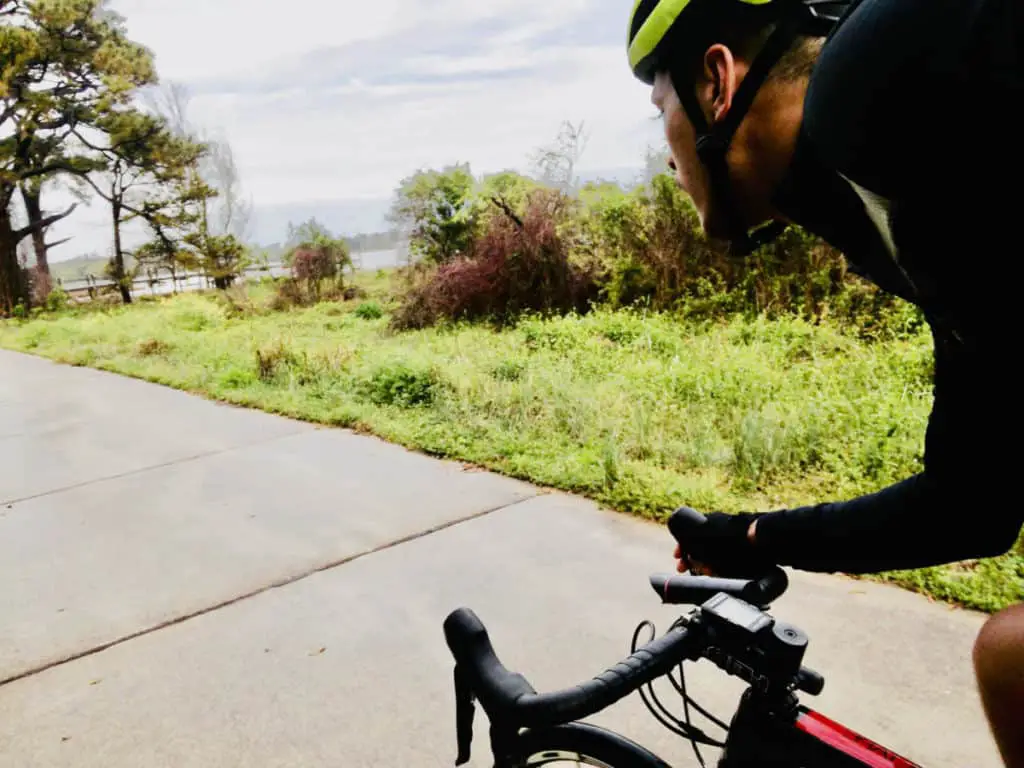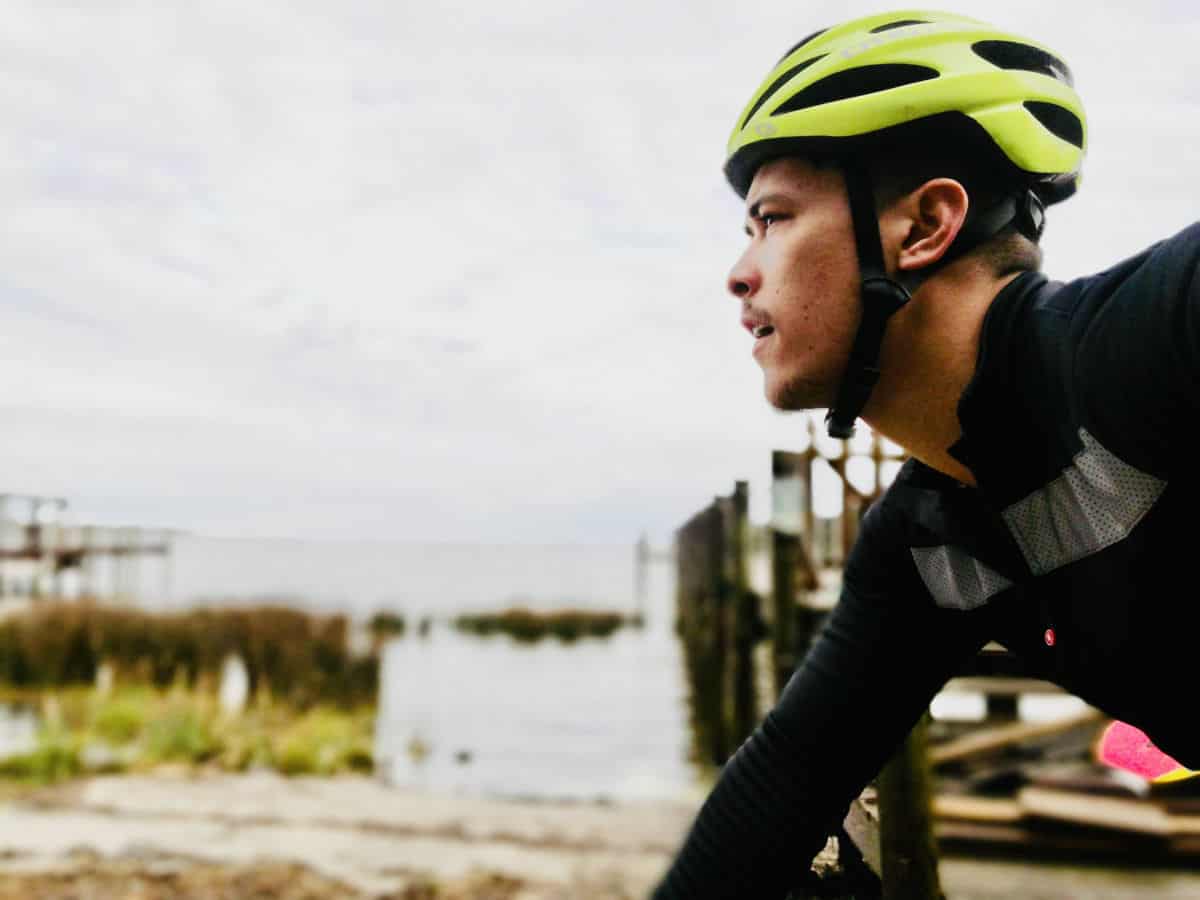Commuting by bike is very attractive for several reasons (including saving money). If you live in a city, it may be a great way to avoid traffic. Or, if you don’t have a lot of time to exercise, commuting to work or doing some errands by bike is a great way to get that activity in. Regardless of why you choose to bike to various destinations, you may be wondering how fast it will take you to commute from point A to B.
I’ve been commuting by bike for 6+ years, even from New Jersey to my job in NYC. I learned a lot of important lessons about riding efficiently and safely in the City that I’m happy to share here.
What’s the average speed of bike commuters?
The average speed cyclists can commute is 11–18 mph (18–29 kph). Advanced cyclists can ride at speeds up to 20-25 mph (32–40 kph). However, it is not likely that they can sustain those speeds, especially if you are riding in the city or have longer commutes.
The average speed on a bike accounts for several factors like traffic, number of stops, physical strength, and endurance. Below, we’ll discuss all of these factors and how they can affect how fast you can commute on a bike.
1. Number of stops
Biking in a city is going to increase your number of stops. Every time the light is red, or there is traffic, you will need to slow down or stop completely. This will take your average speed down.
Urban biking is averaged at 12-16 mph, which is to be expected. It is on the slower side because of the number of stops you’ll have to take and because there are more cars that you have to pay attention to. Additionally, biking on the sidewalk isn’t always an available option to stay clear of these obstacles.
As a cyclist in NYC, I was averaging my 13-mile commute to work around 14 mph, which is okay considering the amount of stop-and-go traffic in NYC.
2. Length of bike ride
Obviously, the length of your bike ride will have an impact on your biking speed. But it doesn’t mean the longer the ride, the quicker the speed, or the shorter the ride, the quicker the speed. The length of the ride simply affects your average speed.
If you are riding in a windy area, such as by a river or waterfront, then you can also factor in wind resistance. A strong headwind, for example, can add another 5 minutes to your commute. A tailwind, on the other hand, is your new best friend.
3. Biking experience
Experience in biking plays a major role. A beginner might be a little too nervous about going fast and, in general, feel off-balanced when starting and stopping. Endurance also plays a factor, which is why the average speed of a beginner biker lies around 10-12 mph.
When I started commuting to my job in NYC from New Jersey, it took me on average about 1 hour to bike 13 miles. After just a few months of doing that commute daily, I was able to get there in about 45–50 minutes. This is significant considering that NYC has tons of traffic and stop signs.

Are you average? How fast an average person can bike
While the average pace of riding a bike is between 12–16 mph (19–25 kph), this can vary for many reasons, including the few already mentioned above.
1. Strength
Strength has a direct impact on how fast the average person can bike. The stronger someone’s legs are, the harder they can push for longer periods.
For instance, if you are riding in a city environment, strength may not matter because the area will be flat. However, if you are biking in an area with lots of hills, it will be harder for those who have weaker legs to push through for longer periods. Because the average person is someone who is not training as a cyclist, strength will vary.
In the end, you will get stronger within a very short period (even just a few weeks).
2. Height and size
Strength is a result of a few things, height and size being one of them. The longer your legs are, the easier it is to push down on the pedals and go faster. Being lightweight also makes things easier to a degree as far as the power you produce when pedaling.
That brings us to the almighty strength to weight ratio. Basically, the idea is that the stronger you are in relation to your weight, the easier biking will be for you. A light, skinny rider with a powerful set of legs is typically the ideal cyclist. Think about all the Tour de France athletes! Skinny and strong for sure.
Of course, the opposite can be said too. Weight sometimes has a direct impact on fitness. If you are out of shape or overweight, biking can be a great way to get exercise. However, it can also be difficult to go long distances at first.
Overall, your height and size don’t really matter unless you’re planning to be a pro cyclist! For daily commuting, you are perfectly capable of pedaling yourself along and you WILL get stronger and lighter over time. Win-win!
3. Type of bike
The type of bike you have will also have an impact on how fast you can go. Now, most bikes will do just fine, but make sure the bike fits you and is of decent quality—this will impact your speed. Here are some different kinds of bikes and what to expect with speed when you ride them:
Mountain bikes
Mountain bikes are naturally going to be a bit slower on the pavement because they are designed for casual, off-road riding. The pros of these bikes are that they have thicker tires that are suited for off-road biking and winter riding. So if your route frequently takes you off paved paths, then this might be the bike for you.
However, keep in mind that this bike is not designed for speed but rather a more comfortable ride.
Road bikes
Road bikes are meant for speed and are frequently used by commuters that want to get there fast. They are very light and agile bikes with thin wheels that are made to move. These bikes are easier to produce power and will not work well off-road. In fact, they can be dangerous off the road because of how quickly they can pick up speed and the higher risk of a puncture.
Personally, I recommend using a road bike for bike commuting.
Hybrid bikes
Sometimes referred to as combination bikes, these bikes have a road bike’s speed and a mountain bike’s comfort. They offer great comfort and are a suitable middle-of-the-road option, which is why they are a popular option for those who aren’t looking to be a road cyclist but want to pick up speed and be comfortable.
These are especially ideal for people that like the benefits of road bikes but don’t feel comfortable or confident on a road bike.
How long does it take to commute by bike?
While the time required to commute by bike is dependent on the rider and the listed variables above, we can use averages to figure out how long it will take someone to bike 5 to 20 miles.
If you are biking a straightaway with no interruptions and your speed is 15 mph, then the following can be said:
| Miles to Travel | Time it Takes to Travel |
| 5 miles | 20 minutes |
| 10 miles | 40 minutes |
| 15 miles | 1 hour |
| 20 miles | 1 hour, 20 minutes |
If you were to maintain a consistent pace with no straightaways, this is an approximation of how long it would take you to travel these distances. However, the longer you bike, the more tired you become. This will result in you slowing your pace over time, which can add to your final time for commuting. You’ll also need to factor in the time you take for any stops for rest, lights, or moving around traffic.
When I decided to start biking to my work in NYC, the first thing I did was time how long my commute was by bus. It took just about 1 hour 5 minutes on average by bus from my house to the office. Then I timed my biking, and I averaged 1 hour from door to door. After a few months of biking daily, my commute was down to 45–50 minutes. The notable thing here is that biking was faster than taking the bus from New Jersey on average. Mind-blowing!
On top of that, I managed to save $400 per month in bus and train fees. I wrote this whole article on how much money you can save from biking.
How to bike faster
Biking faster would mean you need to improve the variables you can control and plan for the variables you can’t. Here are some examples of how you can bike faster in general. Remember, biking speed can mostly be controlled according to the individual, so you may need to adjust certain things based on your personal needs.
- Improve your physical health to bike faster for longer periods by riding daily
- Work on getting more comfortable biking at higher speeds (practice braking fast)
- Trade-in your mountain bike for a road bike or a hybrid
- Plan out better routes that avoid congestions and traffic (Google Maps is your friend)
These are just a few things within your control that you can do to increase your biking speed.
Final thoughts
In general, the average biker can commute at a pace of 11-18 mph, though there is the potential to reach speeds up to 20-25 mph. Within just a few months of consistently biking every day to work or school, you will see improvements and you will reach higher speeds.
Having said that, if your speed seems to be lower than your biking buddy, there’s no reason for concern. Various factors, such as your physical size and fitness, route, type of bike, and more can affect your final pace. Luckily, you can do a few things to gain greater speed should you decide you need the extra boost.
Ride on!

